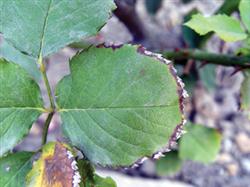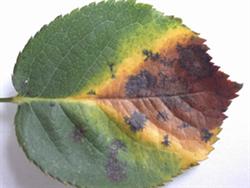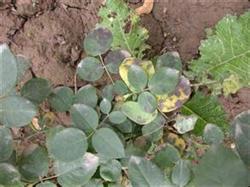Identification and control of black spot of rose

The disease is common and does serious harm, resulting in a large number of fallen leaves of rose and huge losses. The pathogen is a fungus of the genus Actinomyces. First, at the beginning of symptom recognition, brown radial disease spots appear on the leaf surface, and then gradually expand into round or near-round disease spots, with a diameter of 412 mm; in severe cases, the lower leaves fall off in the early stage, gradually spread upward, and eventually the upper leaves will lose light. Rainy and humid is the main condition for spore production, there are water droplets on the leaf surface, and under the appropriate temperature, it can invade in 6-10 hours and appear symptoms in 3-6 days. The disease resistance of rose of yellow flower line is poor. Second, prevention and control techniques 1. Field cultivation, selection of disease-resistant varieties. 2. Cut off the diseased branches in winter, clean up the fallen leaves in the field or in the basin, and burn them. 3. Pay attention to spray protection. Starting from April, spray Bordeaux solution with 1D and 160 Bordeaux once a week; from June to August, you still need to spray Bordeaux liquid, or 50% carbendazim wettable powder 500 times, or 75% chlorothalonil wettable powder 500 times; or 70% mancozeb wettable powder 500 times 600 times.
- Prev

Incidence and control measures of black spot of rose
Black spot of rose is a worldwide disease, which is widely distributed and occurs in all areas where rose is cultivated. In recent years, the disease is serious in many provinces and cities in China. The occurrence of black spot can cause the early defoliation of rose, affect the growth of rose and the survival rate of branch cutting, and reduce the ornamental and economic value. Black spot can also harm roses, roses, etc.
- Next

Common diseases of rose and their control
Symptoms: purple-brown dots appeared in the leaves at the beginning of the disease, and then expanded into nearly round black-brown spots, with radial yellow halos on the edges. In severe cases, the disease spots are connected, and the leaves wither and fall off, especially in summer and autumn, resulting in a large number of fallen leaves, and there is a smooth rod under the plant. After being infected, the tender shoots appear black-brown stripes, which are slightly sunken, resulting in tender.
Related
- Fuxing push coffee new agricultural production and marketing class: lack of small-scale processing plants
- Jujube rice field leisure farm deep ploughing Yilan for five years to create a space for organic food and play
- Nongyu Farm-A trial of organic papaya for brave women with advanced technology
- Four points for attention in the prevention and control of diseases and insect pests of edible fungi
- How to add nutrient solution to Edible Fungi
- Is there any good way to control edible fungus mites?
- Open Inoculation Technology of Edible Fungi
- Is there any clever way to use fertilizer for edible fungus in winter?
- What agents are used to kill the pathogens of edible fungi in the mushroom shed?
- Rapid drying of Edible Fungi

